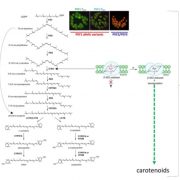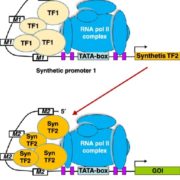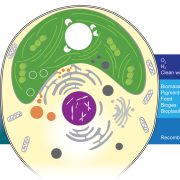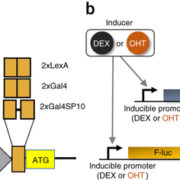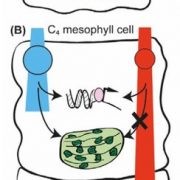Review: Increasing metabolic potential: C-fixation (Essays Biochem) $
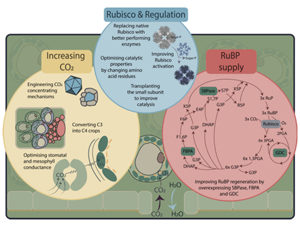 Increasing carbon fixation through the Calvin-Benson-Bassham (CBB) cycle is a viable strategy to boost crop yields, as has been demonstrated through both experimental and modelling approaches. In this review, Andralojc et al outline the most recent advancements in this research field. The authors firstly describe the reaction mechanism of the carbon-fixing enzyme Rubisco, and introduce the various drawbacks of this protein including its liability to misfire or be inhibited, its slow speed compared to other CBB cycle enzymes, and its oxygenase activity. Specificity of Rubisco for CO2 over O2 has long been thought to be part of a trade-off with the catalytic rate of the enzyme. Recently however, extensive biochemical characterisation of Rubisco from a large number of species and lineages has revealed that this trade-off does not always hold, indicating it should be possible to engineer a fast Rubisco with high specificity for CO2. The authors conclude this section by describing how existing computer models of photosynthesis have corroborated that an engineered Rubisco holoenzyme could boost crop yields, as-well-as the prospects of introducing such a protein into crops. This review then discusses the role of Rubisco activase (Rca) in modulating carbon fixation. Rca removes inhibitors from Rubisco in an ATP-dependent manner, a process important for the induction of photosynthesis during low-to-high light transitions (akin to the fluctuating light conditions in the field). The latest research efforts to speed up this induction are described, as are attempts to speed up the regeneration of Rubisco’s substrate (RuBP) through the CBB cycle. Finally, the authors outline potential ways of increasing CO2 in the vicinity of Rubisco, including modulating mesophyll CO2 conductance and the installation of CO2 concentrating mechanisms (CCMs). (Summary by Mike Page) Essays Biochem 10.1042/EBC20170014
Increasing carbon fixation through the Calvin-Benson-Bassham (CBB) cycle is a viable strategy to boost crop yields, as has been demonstrated through both experimental and modelling approaches. In this review, Andralojc et al outline the most recent advancements in this research field. The authors firstly describe the reaction mechanism of the carbon-fixing enzyme Rubisco, and introduce the various drawbacks of this protein including its liability to misfire or be inhibited, its slow speed compared to other CBB cycle enzymes, and its oxygenase activity. Specificity of Rubisco for CO2 over O2 has long been thought to be part of a trade-off with the catalytic rate of the enzyme. Recently however, extensive biochemical characterisation of Rubisco from a large number of species and lineages has revealed that this trade-off does not always hold, indicating it should be possible to engineer a fast Rubisco with high specificity for CO2. The authors conclude this section by describing how existing computer models of photosynthesis have corroborated that an engineered Rubisco holoenzyme could boost crop yields, as-well-as the prospects of introducing such a protein into crops. This review then discusses the role of Rubisco activase (Rca) in modulating carbon fixation. Rca removes inhibitors from Rubisco in an ATP-dependent manner, a process important for the induction of photosynthesis during low-to-high light transitions (akin to the fluctuating light conditions in the field). The latest research efforts to speed up this induction are described, as are attempts to speed up the regeneration of Rubisco’s substrate (RuBP) through the CBB cycle. Finally, the authors outline potential ways of increasing CO2 in the vicinity of Rubisco, including modulating mesophyll CO2 conductance and the installation of CO2 concentrating mechanisms (CCMs). (Summary by Mike Page) Essays Biochem 10.1042/EBC20170014


